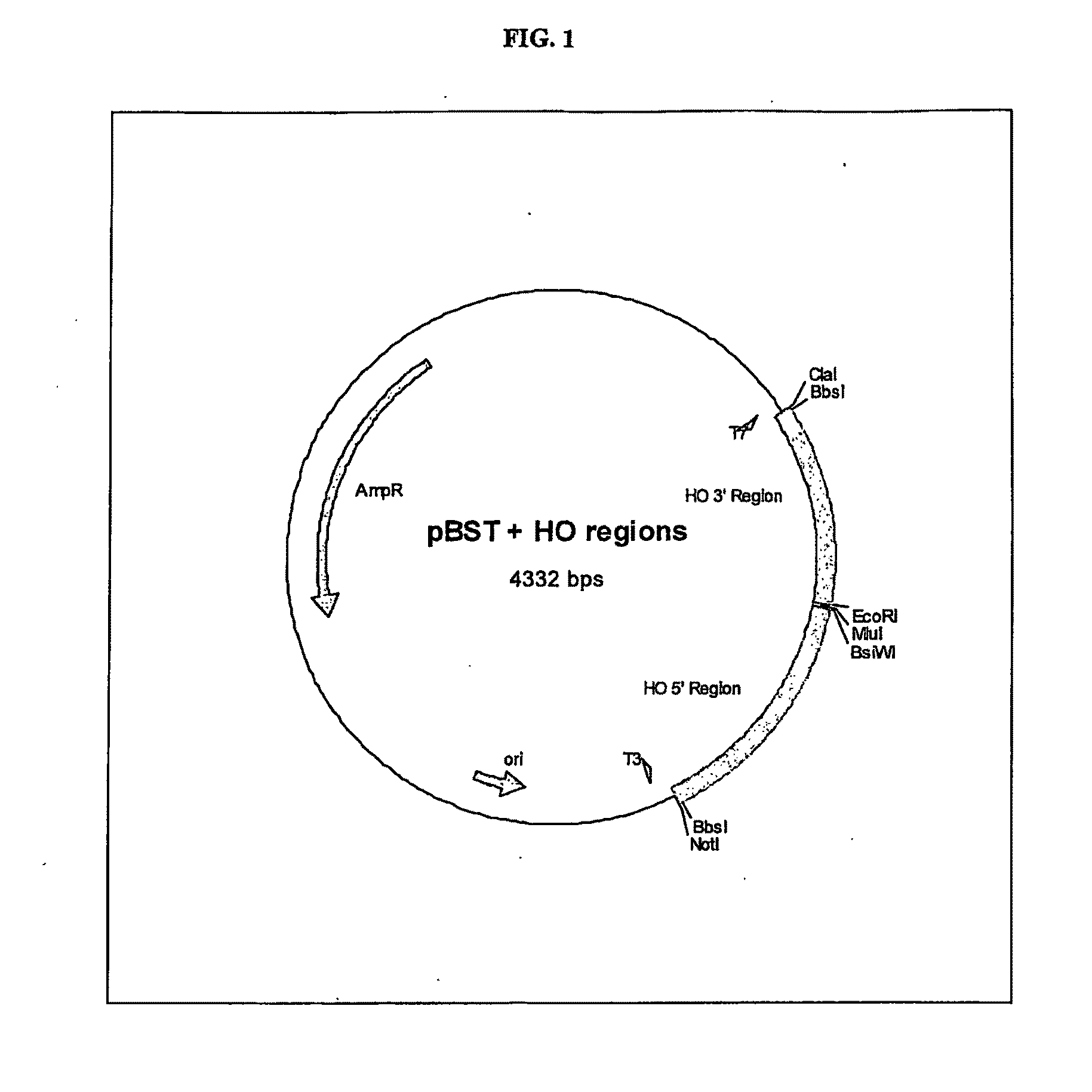Gene Expression Technique
a gene and expression technology, applied in the field of gene expression techniques, can solve the problem of nothing in the art to sugges
- Summary
- Abstract
- Description
- Claims
- Application Information
AI Technical Summary
Benefits of technology
Problems solved by technology
Method used
Image
Examples
example 1
[0589]A strain of S. cerevisiae that possesses increased production of a recombinant protein was produced by the following methodology.
[0590]Strains. The S. cerevisiae strain used was a histidine revertant of AH22 (ciro a leu2-3 leu2-112 his4 canR). AH22 is further described in Mead at al, 1986, Mol. Gen. Genet., 205, 417-421. A polynucleotide encoding a recombinant heterologous protein expression cassette was introduced by S. cerevisiae transformation performed according to Ito, H., at al. (Transformation of intact yeast cells treated with alkali cations. J. Bacterial. 153, 163-168, (1983)).
[0591]Media. Yeast strains were grown in rich broth medium, YEP (1% yeast extract 2% w / v Bactopeptone).
[0592]Protein assays. Yeast cells were grown in 10 ml cultures for 72 hours to a density of 5×107 cells / mL at 30° C. in YEP 2% (w / v) sucrose. In order to analyse the soluble heterologous protein fraction of yeast, cells were harvested by centrifugation and disrupted in phosphate buffered saline...
example 2
[0595]The expression of genes in the strain identified in Example 1 was compared to the expression of genes in the ancestral strain from which it was derived (i.e. the ancestral strain displays lower levels of production of a recombinant protein).
[0596]The comparison was made by using microarray analysis. Yeast cells to be analysed were grown in 100 ml defined medium (0.65% (w / v) YNB; 2% (w / v) dextrose; Na2HPO4 / citric acid pH 6.5) to OD600=2.0. The cells were immediately harvested by centrifugation and frozen by immersion in liquid nitrogen. RNA suitable for microarray analysis was prepared by disruption of the cells using a micro dismembrator (Braun Melsungen, Germany) all as described by Jones et al, 2003, Physiol. Genomics, 16, 107-118. cDNA synthesis, labelling, hybridisation to high-density oligonucleotide arrays (Affymetrix-Yeast S98) and scanning were carried out as described by protocols provided by the manufacturer (Affymetrix Inc, USA). The subsequent data was analysed usi...
example 3
[0599]The example describes the vector construction and yeast transformation for the overexpression of the representative helper proteins LHS1, SLS1, JEM1 and SCJ1.
TABLE 2Primers usedPrimer nameSequence (5′-3′)HO 5′ ForNotIBbsIGCATGCGGCCGCCCGAAGACCCTACACAGGGCTTAAGGGCHO 5′ RevBsiWIMluICCACGCGTCGTACGGGATTGCTGCTTATGAGGATAHO 3′ ForMluIEcoRIACGCGTGAATTCAAAAAGGGAACCCGTATATTTCAGCHO 3′ RevBbsIClaITATCGATAGTCTTCCTAATATACACATTTTAGCAGATGCpBST HO Poly ForGCATGCATACGCGTCACGCATGTGCCTCAGCGGCCGGCCGGCGCCGGGCCCCGGACCGCCTGCAGGCTCGAGTTAATTAAGTTTAAACGAATTCGCATGCATpBST HO Poly RevATGCATGCGAATTCGTTTAAACTTAATTAACTCGAGCCTGCAGGCGGTCCGGGGCCCGGCGCCGGCCGGCCGCTGAGGCACATGCGTGACGCGTATGCATGCYcplac33 Poly ForCTAGATTGGATCCCTAGTCTAGGTTTAAACTAGCGATTCACCTAGGTGCTAGGAATTCTAGCYcplac33 Poly RevGCTAGAATTCCTAGCACCTAGGTGAATCGCTAGTTTAAACCTAGACTAGGGATCCAATCTAGLHS1forOverlapCACAATATTTCAAGCTATACCAAGCATACAATCAACTATCTCATATACAATGCGAAACGTTTTAAGGCTLHS1revBbvCIGCATGCTGAGGGTGCCACTATAATATTAATGTGCSLS1forOverlapCACCAACACACACAAAAAACAGTACTTCA...
PUM
 Login to View More
Login to View More Abstract
Description
Claims
Application Information
 Login to View More
Login to View More - R&D
- Intellectual Property
- Life Sciences
- Materials
- Tech Scout
- Unparalleled Data Quality
- Higher Quality Content
- 60% Fewer Hallucinations
Browse by: Latest US Patents, China's latest patents, Technical Efficacy Thesaurus, Application Domain, Technology Topic, Popular Technical Reports.
© 2025 PatSnap. All rights reserved.Legal|Privacy policy|Modern Slavery Act Transparency Statement|Sitemap|About US| Contact US: help@patsnap.com



